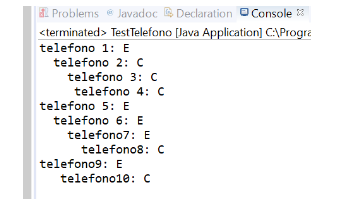Estoy realizando un ejercicio pero no logro entender bien la lógica del punto de validar los caracteres
Clase telefono
public class Telefono {
// Atributos
private String nombre;
private String tipo;
private String estado;
// Constructor
public String Telefono(String nombre, String tipo) {
this.nombre = nombre;
this.tipo = tipo;
if (this.getNombre() != null && this.getTipo() != null)
if (this.tipo.equals("movil") && this.tipo.equals("convencional")) {
return this.tipo = "e";
} else {
return this.tipo = "C";
}
return tipo;
}
// Getters & Setters
public String getNombre() {
return nombre;
}
public String getTipo() {
return tipo;
}
public String getEstado() {
return estado;
}
}
Clase Main
package com.cmc.test;
import com.cmc.entidades.Telefono;
public class TestTelefono {
public static void main(String[] args) {
Telefono telefono1=new Telefono("0992920306", "convencional");
System.out.println("telefono 1: "+telefono1.getEstado());
Telefono telefono2=new Telefono("0992920306", "MOVIL");
System.out.println(" telefono 2: "+telefono2.getEstado());
Telefono telefono3=new Telefono("0992920306", "Movil");
System.out.println(" telefono 3: "+telefono3.getEstado());
Telefono telefono4=new Telefono("2375467", "CONVENCIONAL");
System.out.println(" telefono 4: "+telefono4.getEstado());
Telefono telefono5=new Telefono("0992920306",null);
System.out.println("telefono 5: "+telefono5.getEstado());
Telefono telefono6=new Telefono(null,"Convencional");
System.out.println(" telefono 6: "+telefono6.getEstado());
Telefono telefono7=new Telefono(null,"Convencional");
System.out.println(" telefono7: "+telefono7.getEstado());
Telefono telefono8=new Telefono("2387991","convencional");
System.out.println(" telefono8: "+telefono8.getEstado());
Telefono telefono9=new Telefono("2387991","Fijo");
System.out.println("telefono9: "+telefono9.getEstado());
Telefono telefono10=new Telefono("2222222","CoNvEnCiOnAL");
System.out.println(" telefono10: "+telefono10.getEstado());
}
}
Debo realizar la siguiente condición en constructor
Agregar un constructor que reciba el número y el tipo y ejecute la siguiente lógica: Asigna los valores de número y tipo a los atributos respectivos. Dependiendo de las validaciones que realice, colocará el valor de estado: C : Si es correcto E : Si tiene error
Para determinar si es correcto o no el teléfono, se debe cumplir las siguientes condiciones:
Tanto el teléfono como el tipo deben ser diferentes de null, si alguno es null, se considera con error
Los tipos pueden ser Movil o Convencional, si es un tipo diferente, se considera con error.
Si el tipo es Movil, el teléfono debe tener 10 caracteres, si es convencional, debe tener 7 caracteres. Validar únicamente la longitud, no el contenido de la cadena. La longitud de un String se obtiene con el método length()
El resultado esperado en la clase test:
